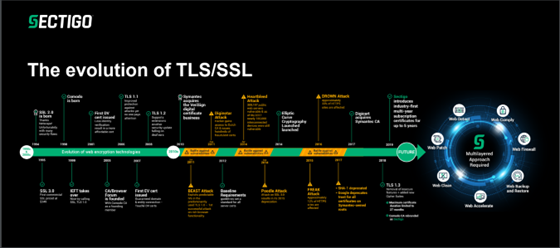Secure Sockets Layer (SSL) is a security protocol that enables encrypted digital communications—between a web browser like Google Chrome or Mozilla Firefox and a web server, for example. SSL certificates authenticate the identity of an online entity and secure online communications with that entity.
SSL was created in 1995, and 2.0 was the first version of SSL used in production. After the introduction of SSL 3.0, standards bodies replaced SSL with Transport Layer Security (TLS), a more secure protocol. However, the term SSL was used so commonly that it persisted as the de facto name for TLS.

What does SSL deprecation mean for organizations? This article will explore the rea
sons behind SSL deprecation, vulnerabilities of the SSL protocol, and the transition to TLS.
When was SSL deprecated?
The Internet Engineering Task Force (IETF) officially deprecated SSL 3.0 in June 2015. While the IETF discouraged the use of deprecated SSL protocols, providers of individual software systems are responsible for determining the SSL 3.0 end-of-life date.
Most organizations have transitioned to the TLS protocol. TLS 1.0 and TLS 1.1 were the older versions, and companies should upgrade to TLS 1.2 and TLS 1.3 whenever possible.
Why SSL was deprecated
In September 2014, a team of Google security researchers discovered a serious SSL 3.0 vulnerability called POODLE, or Padding Oracle on Downgraded Legacy Encryption, which hackers can exploit to decrypt secure communications and steal confidential information. The news diminished SSL's credibility as a reliable encryption method, and security experts recommended SSL be retired.
Additionally, the SSL protocol relied on older encryption algorithms and was no longer enough to protect against new attack techniques. The need for more robust security in the face of evolving cyber threats has led to the TLS protocol.
TLS vs. SSL security protocols
TLS was introduced as SSL's successor and has become the primary cryptographic protocol for the internet. It fixed various SSL security issues, including cipher suite vulnerabilities, POODLE attacks, cipher block chaining (CBC), and renegotiation vulnerabilities.
TLS 1.3, the latest TLS version, is faster and more secure. It uses ephemeral key exchange to reduce the risk of compromised session keys. It also eliminates older cryptographic algorithms for better performance. However, TLS 1.2 is still widely used due to the absence of known vulnerabilities and TLS 1.3's backward-compatibility challenges.
Why do people still refer to TLS as SSL?
SSL's prominence in the early internet days and widespread usage have made it synonymous with secure communication, even long after TLS has taken over. Meanwhile, people who don't have an in-depth understanding of cybersecurity often use the two terms interchangeably, adding to the misconception and confusion.
Today, the term "SSL certificate" is still widely used, even by those in the security industry. For example, many Certificate Authorities (CAs) continue to use "SSL certificate" as a colloquial term for all digital certificates for encryption and authentication. TLS certificates are often called SSL/TLS certificates to simplify communication and avoid misunderstanding.
The future of internet security: Beyond TLS 1.3
We must invest in ongoing efforts to enhance internet security protocols and adapt to emerging threats. TLS will evolve to address vulnerabilities, improve encryption algorithms, and optimize handshakes for faster connections. In particular, quantum computers can easily break traditional cryptographic algorithms, and we expect the TLS protocol to include updates on post-quantum cryptography and quantum-resistant algorithms.
Meanwhile, the validity of TLS certificates is shortening. The 90-day lifecycle will improve the security of online communications. But it will also make it more challenging for organizations to manage their digital certificates effectively to avoid outages and disruptions.
SSL deprecation was a crucial move toward improved online communication security. The TLS protocol addressed critical vulnerabilities and set the stage for future improvement as we head into the quantum computing era. Obtaining TLS certificates from a reputable CA and effective certificate management are critical to ensuring compliance, security, and business continuity.
Learn more about Sectigo's TLS certificates and the Sectigo Certificate Manager to see how we can help you navigate the future of encryption and cybersecurity.
The post SSL Deprecation: Understanding the Evolution of Security Protocols appeared first on Security Boulevard.
Nick France
Source: Security Boulevard
Source Link: https://securityboulevard.com/2023/08/ssl-deprecation-understanding-the-evolution-of-security-protocols/